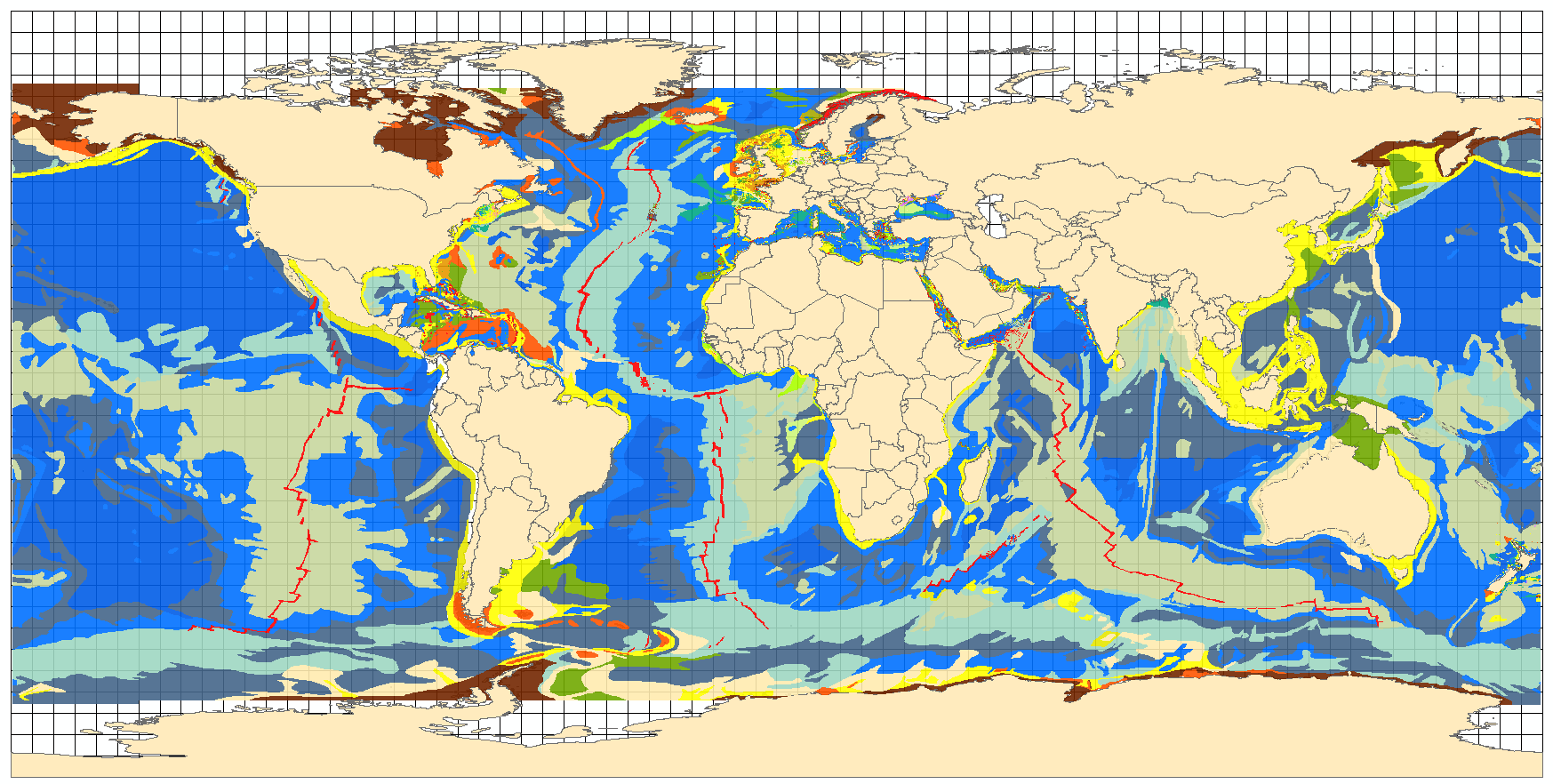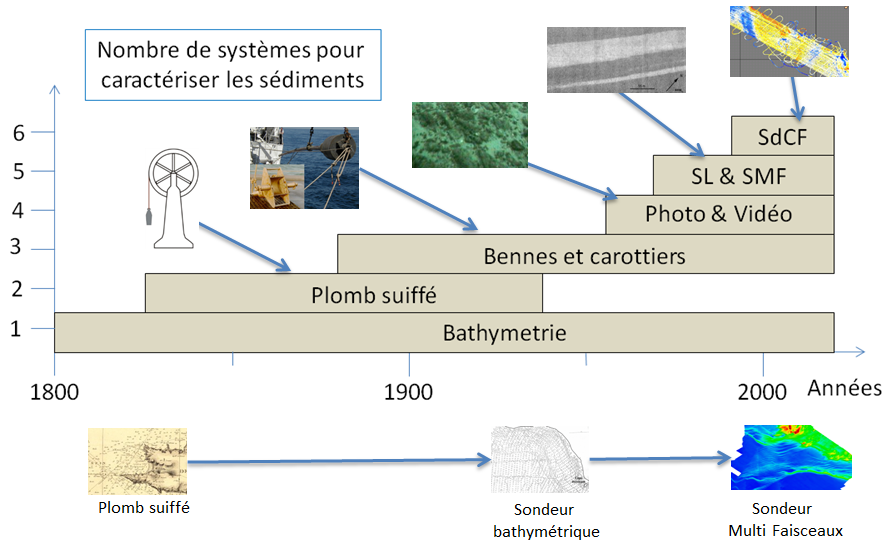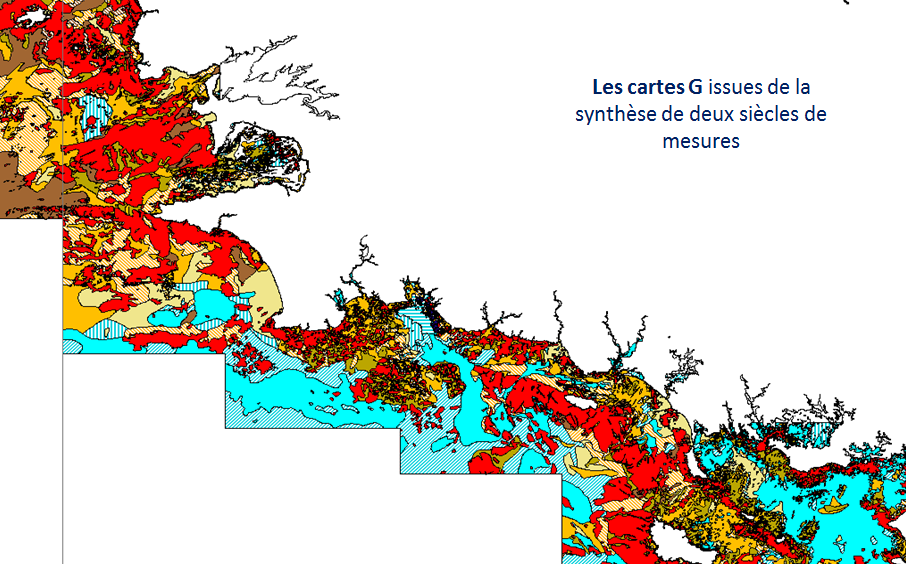
Marine sedimentology
Mis à jour le 19/07/2024
De l’acquisition des données à l’étude de leur répartition et leur dynamique
La nature des sédiments est un facteur important influençant l’hydrodynamique ou la propagation des vagues aux abords du littoral. Les sédiments sont également utiles pour les cartes marines où ils servent à définir la route la plus sûre, les zones à risque potentiel et les zones où le point d’ancrage est idéal. La connaissance de la nature des fonds marins est plus importante encore pour l’installation et la surveillance des pipelines et câbles sous-marins, pour l'extraction d'agrégats marins, la mise en place des énergies marines renouvelables et la recherche d'anciennes épaves ou d'anciens engins explosifs partiellement ou complètement enfouis.
Pour tous ces besoins, des informations détaillées et précises sont nécessaires concernant la nature, l'épaisseur, l'étendue et la dynamique des sédiments. L’enfouissement et la réapparition de bombes de la seconde guerre mondiale proviennent de l’impact des courants, des houles, du poids et de la forme de l’objet ; mais le facteur déterminant la possibilité ou l’impossibilité de l’enfouissement est la nature du fond marin. Le besoin des pêcheurs et des biologistes est aussi important car la vie des organismes benthiques dépend étroitement de la nature des sédiments et de leur dynamique. Les sédiments sont ainsi un facteur impactant la biologie et un marqueur des tempêtes et des évolutions passées et présentes du niveau marin.
L’étude des sédiments marins est une activité très ancienne du Shom avec de premières acquisitions de la nature des sédiments dans les années 1800. A la fin du 19ème siècle le service hydrographique publiait une première carte des sédiments de la Mer d’Iroise à partir de prélèvements de sédiments effectués en grand nombre avec le plomb suiffé mais aussi, dès cette époque avec des bennes et des carottiers. Comme les autres sciences, la sédimentologie est soumise à une croissance et à une diversification des techniques utilisées, à une interaction accrue avec d'autres sciences et à une fragmentation de l'information. L'arrivée successive des nouveaux systèmes de prélèvement, de systèmes d'imagerie acoustique et de données de la morphologie des fonds de plus en plus précises a généré une amélioration de la précision des données et de la connaissance des processus.
Chaque année, les surfaces étudiées avec les moyens nautiques actuellement utilisés couvrent moins de 1% des plateaux continentaux. Il est donc impossible d'avoir une couverture globale de qualité homogène étudiée avec de nouveaux systèmes. La solution mise en œuvre consiste donc à rechercher toutes les données, à les intégrer dans la base de données sédimentologiques du Shom puis à produire des cartes de sédiments à différentes échelles allant du 1/10 000 pour les études d’impact au 1/500 000.
Il est ainsi de plus en plus nécessaire de disposer de cartes des sédiments très précises près des côtes et de cartes des fonds marins à moyenne échelle sur le plateau continental et les grand-fonds océaniques. Il faudra néanmoins plus d'un siècle avant de disposer d'une cartographie basée sur des données acquises avec des moyens modernes. La solution adoptée par le Shom ici est de partir d'une connaissance approximative établie avec les moyens du passé et de la compléter progressivement avec les données les plus récentes afin de disposer de cartes sédimentaires locales et globale à jour de la connaissance.
La dynamique des sédiments
La nature des fonds marins peut être résumée à 4 classes principales : la roche, les cailloutis et graviers, les sables et les vases.
La roche est le lieu privilégié du développement des organismes marins et peut présenter des reliefs importants rendant sa localisation importante pour la biologie et la sécurité de la navigation. C’est également le domaine de la stabilité, les seuls changements observés correspondant à des phénomènes d’érosion sur leur pourtour ou des phénomènes de recouvrement de plus ou moins grande durée par les sédiments.
Les cailloutis et graviers engendrent des fonds plats et stables à l’exception de secteurs très énergétiques tel que le Raz Blanchard où ces éléments peuvent être déplacés par les courants et former des mégarides.
A l’opposé les sédiments les plus fins : les vases engendrent des fonds plats où les structures sédimentaires sont des dépressions, dues à l’évacuation du gaz interstitiel, pouvant former des cratères de quelques centaines de mètres de diamètre dans certains environnements hors métropole. Les vases sont des environnements importants pour la biologie et le piégeage des polluants pouvant être remis en suspension par les courants ces vases sont la principale source de la turbidité.
Les sables sont des particules variant de 50 microns à 2 mm dont la particularité est de se mettre facilement en mouvement et de constituer des dunes. Les dunes sous-marines sont comparables à celles rencontrées sur certaines planètes, dans les déserts et dans les rivières. Leur seules différences est qu’elles sont constituées de sédiments hétérogènes pouvant comprendre des graviers et galets et que leur hauteur est moindre que celle des dunes éoliennes puisqu’en domaine marin les dunes les plus hautes avoisinent au maximum 30 mètres alors qu’elles peuvent être 10 fois plus hautes dans les déserts. Le Shom consacre des études sur ces dunes depuis plus de 20 ans car ces structures se déplacent sur le fond à des vitesses les plus souvent de quelques mètres par an mais pouvant parfois dépasser 50 mètres par an. De telles dunes couvrent tous les fonds marins au nord et à l’ouest de la Bretagne par des profondeurs comprises entre 70 et 220m. Elles sont aussi des centaines dans le chenal de navigation de la Mer du Nord engendrant des reliefs de 19 à 25m de profondeur où des bateaux présentent des tirants d’eau de plus de 20 mètres. Enfin leur déplacement est la cause du masquage d’épaves et d’engins explosifs durant des périodes qui peuvent dépasser le siècle. L’activité menée par le Shom sur ces dunes comprend des levés récurrents, des études visant à développer de modèles devant permettre à terme l’optimisation des levés et l’organisation de conférences internationales (Marine and River Dune Dynamics) depuis 2000.



